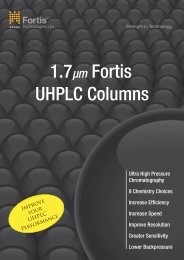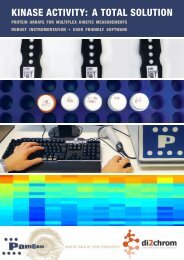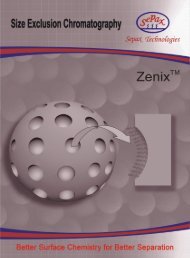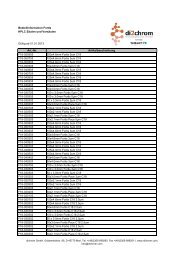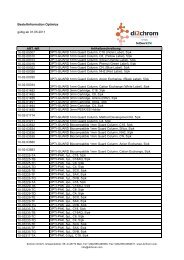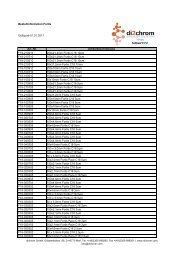Determination of inorganic anions in water samples ... - dichrom
Determination of inorganic anions in water samples ... - dichrom
Determination of inorganic anions in water samples ... - dichrom
Create successful ePaper yourself
Turn your PDF publications into a flip-book with our unique Google optimized e-Paper software.
HIGH PERFORMANCE<br />
CAPILLARY<br />
ELECTROPHORESIS SYSTEM<br />
CAPEL ® series<br />
DETERMINATION OF INORGANIC ANIONS IN WATER SAMPLES<br />
ACCORDING TO EPA 6500 AND ASTM D 6508-00 TEST METHODS<br />
EPA 6500<br />
ASTM D 6508-00<br />
INTRODUCTION<br />
The method allows determ<strong>in</strong>ation <strong>of</strong> <strong><strong>in</strong>organic</strong> <strong>anions</strong>: fluoride, bromide, chloride, nitrite, nitrate, sulfate, and<br />
ortho-phosphate ions <strong>in</strong> <strong>samples</strong> <strong>of</strong> natural, potable and waste <strong>water</strong>.<br />
MEASURING METHOD<br />
The capillary electrophoresis method for determ<strong>in</strong>ation <strong>of</strong> <strong><strong>in</strong>organic</strong><br />
<strong>anions</strong>’ concentrations is based on differential migration and<br />
separation <strong>of</strong> <strong>anions</strong> <strong>in</strong> the electric field due to different<br />
electrophoretic mobility. Identification and quantitative<br />
determ<strong>in</strong>ation <strong>of</strong> the analyzed <strong>anions</strong> is performed us<strong>in</strong>g <strong>in</strong>direct<br />
detection by measur<strong>in</strong>g the UV absorption.<br />
CONCENTRATION RANGES<br />
Ranges <strong>of</strong> measurable concentrations for analyzed <strong>anions</strong> are<br />
presented <strong>in</strong> the table.<br />
Anions L<strong>in</strong>ear range, mg/l Measurement range, mg/l<br />
Nitrite 5–50 0.1–50<br />
Nitrate 5–50 0.1–50<br />
Ortho-phosphate 5–50 0.1–200<br />
Sulfate 5–50 0.1–1000<br />
Fluoride 2.5–25 0.1–25<br />
Bromide 5–50 0.1–50<br />
Chloride 5–50 0.1–1000<br />
If the concentration <strong>of</strong> an anion <strong>in</strong> an analyzed sample exceeds the upper limit <strong>of</strong> the measurement range, it<br />
is allowed to dilute the sample so that the concentration would be <strong>in</strong> the range from 5 to 50 mg/l (or for<br />
fluoride from 2.5 to 25 mg/l)<br />
EQUIPMENT AND REAGENTS<br />
The follow<strong>in</strong>g equipment and reagents are used <strong>in</strong> measurements:<br />
• The CAPEL ® Capillary Electrophoresis System with high-voltage negative polarity<br />
• Certified anion standard solutions: Cl - (1 mg/ml), NO - 2-<br />
2 (1 mg/ml), SO 4 (1 mg/ml), NO - 3 (1 mg/ml), F -<br />
3-<br />
(1 mg/ml), PO 4 (0.5 mg/ml)<br />
• Distilled <strong>water</strong><br />
• Sodium chromate tetrahydrate, Analytical Grade<br />
• CHES (2-[N-cyclohexylam<strong>in</strong>o]-ethane sulfonic acid), Analytical Grade<br />
• Tetradecyltrimethyl ammonium bromide (TTABr), Analytical Grade, or 100 mM TTAOH solution<br />
• Sodium hydroxide, Analytical Grade<br />
• Calcium gluconate, Analytical Grade<br />
• Anion exchange cartridge, hydroxyde form<br />
Data acquisition, collection, process<strong>in</strong>g, and output are performed us<strong>in</strong>g a personal computer runn<strong>in</strong>g under<br />
WINDOWS ® 98/ME/NT/2000/XP operat<strong>in</strong>g system with <strong>in</strong>stalled Chrom&Spec ® s<strong>of</strong>tware package for<br />
acquisition and process<strong>in</strong>g <strong>of</strong> chromatography data.<br />
PREOPERATIONAL PROCEDURES<br />
Preoperational procedures <strong>in</strong>clude: sampl<strong>in</strong>g and sample preparation, capillary condition<strong>in</strong>g, preparation <strong>of</strong><br />
auxiliary and calibration solutions, and calibration <strong>of</strong> the CAPEL ® Capillary Electrophoresis System.<br />
Samples <strong>of</strong> natural, potable or waste <strong>water</strong> should be collected <strong>in</strong> compliance with EPA sampl<strong>in</strong>g guidel<strong>in</strong>es<br />
(ASTM Practice D 3370).<br />
The sample should be filtered through a prer<strong>in</strong>sed 0.2µm aqueous compatible membrane filter; first portions<br />
<strong>of</strong> the filtrate must be discarded. The sample must be analyzed with<strong>in</strong> 24 hours.
HIGH PERFORMANCE<br />
CAPILLARY<br />
ELECTROPHORESIS SYSTEM<br />
CAPEL ® series<br />
The system is calibrated by measur<strong>in</strong>g signals <strong>of</strong> calibration solutions. Stability <strong>of</strong> the calibration<br />
characteristics is checked directly before sample measurement by record<strong>in</strong>g an electropherogram <strong>of</strong> one <strong>of</strong><br />
the calibration mixtures.<br />
MEASUREMENT PROCEDURE<br />
Pre-test<strong>in</strong>g should be performed prior to ma<strong>in</strong> measurement: it may be necessary to adjust the sample pH<br />
and to elim<strong>in</strong>ate <strong>in</strong>terfer<strong>in</strong>g cations and <strong>anions</strong>.<br />
No less than two specimens should be analyzed for each sample queued. If the measured chloride, nitrite,<br />
sulfate, nitrate and phosphate concentrations exceed 50 mg/l or concentration <strong>of</strong> fluoride exceeds 25 mg/l, it<br />
is necessary to pre-dilute the sample with distilled <strong>water</strong>.<br />
DATA PROCESSING<br />
Chrom&Spec ® s<strong>of</strong>tware outputs a report <strong>of</strong> concentrations (<strong>in</strong> mg/l) <strong>of</strong> analyzed <strong>anions</strong> <strong>in</strong> the solution<br />
prepared for analysis.<br />
EXAMPLE OF REAL ANALYSIS<br />
Buffer: 4.7 mmol chromate, 4 mmol TTAOH, 10 mmol CHES, 0.1 mmol Ca gluconate<br />
Capillary: L EFF /L TOTAL 50/60 cm, ID 75 µm<br />
Injection: 300 mbar*s<br />
Voltage: –15 kV<br />
Detection: 254 nm, <strong>in</strong>direct<br />
Temperature: RT<br />
20 mAU<br />
2<br />
1<br />
Sample: test solution<br />
1 – chloride (20 mg/l)<br />
2 – nitrite (20 mg/l)<br />
3 – sulfate (20 mg/l)<br />
4 – nitrate (20 mg/l)<br />
5 – fluoride (10 mg/l)<br />
6 – phosphate (20 mg/l)<br />
34<br />
5<br />
6<br />
1 2 3 4 m<strong>in</strong><br />
20 mAU<br />
2<br />
Sample: tap <strong>water</strong><br />
Measurement results:<br />
1 – chloride (7.78 mg/l)<br />
2 – sulfate (26.3 mg/l)<br />
3 – nitrate (1.66 mg/l)<br />
1<br />
3<br />
40 mAU<br />
1 2 3 4 m<strong>in</strong><br />
1<br />
Sample: foul <strong>water</strong> (diluted 1:4)<br />
Measurement results:<br />
1 – chloride (532 mg/l)<br />
2 – sulfate (23.1 mg/l)<br />
3 – phosphate (6.8 mg/l)<br />
2<br />
3<br />
1 2 3 4 m<strong>in</strong><br />
The contents on this paper are subject to change without notice.



